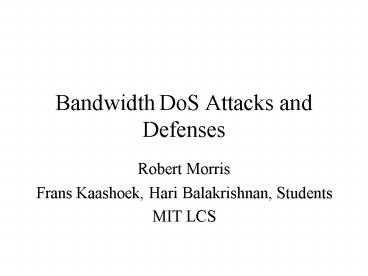Bandwidth DoS Attacks and Defenses - PowerPoint PPT Presentation
Title:
Bandwidth DoS Attacks and Defenses
Description:
Bandwidth DoS Attacks and Defenses. Robert Morris. Frans Kaashoek, Hari Balakrishnan, Students ... What is a Denial of Service Attack? Goal: make a service unusable. ... – PowerPoint PPT presentation
Number of Views:128
Avg rating:3.0/5.0
Title: Bandwidth DoS Attacks and Defenses
1
Bandwidth DoS Attacks and Defenses
- Robert Morris
- Frans Kaashoek, Hari Balakrishnan, Students
- MIT LCS
2
What is a Denial of Service Attack?
- Goal make a service unusable.
- How overload a server, router, network link.
- Focus bandwidth attacks (trinoo, tfn).
3
Logical View of Attack Net
Attacker
Control Traffic
Master
Slave
Slave
Slave
Slave
Slave
Attack Traffic
Victim
4
Attack Targets
Link
Router
Customers Router
ISP
Host
Other ISPs
App
O/S
Other Customers
Customers LAN
5
Attacks use IP Packets
IP Header Source Address Destination
Address User Data
- Routers forward each packet independently.
- Routers dont know about connections.
- Complexity is in end hosts routers are simple.
6
Outline
- Case study Yahoo.
- What happened.
- Analysis.
- Our framework for defense RON.
7
Case Study Yahoo Attack
- Early February 2000.
- Took Yahoo off the net for hours.
8
Yahoos Point of View
ISP Router
1 Gbit/second of Ping Response packets.
Yahoos Router
www.yahoo.com
9
Yahoo Attack Overview
Co-location Centers
Other ISPs
Yahoos ISP
Yahoo
10
Attack Packet Generation
Leader
Slaves
Co-location Center
M
S1
S2
Sn
Ping, DSTbcast, SRCYahoo
Ping Responses, DSTYahoo
Internet
11
What did the attack depend on?
- Pervasive insecure hosts.
- Fake IP source addresses.
- Use of hosts as amplifiers.
- Weak router software.
- Difficulty of diagnosis.
12
Pervasive Insecure Hosts
- Required for disguise and to generate enough
traffic. - How do they break in?
- Buffer overruns.
- Typically Solaris and Linux.
- Highly automated.
- Defenses?
- Better programming practices.
- Disable services by default.
- Firewalls, intrusion detection.
- Motivation for deployment is not strong.
13
Fake IP Source Addresses
- Two uses
- Hide the source of attack.
- Part of weapon.
- Example SYN flooding.
- Defense
- Ingress/egress filtering.
- But motivation for deployment is not strong.
14
Ingress Filtering
Attacker SRCSite2
Site 1
Site 2
ISP 1
ISP 2
ISP 3
Victim
15
Use of Hosts as Amplifiers
- Attackers need this
- To avoid using their own machines.
- To generate lots of traffic.
- To avoid detection via load monitoring.
- Two approaches
- Break into 1000s of machines.
- Trick legitimate machines into generating traffic.
16
Weak Router Software
- Routers themselves are often victims.
- Why?
- Forwarding and management compete for CPU.
- Control and data traffic compete for net b/w.
- Solutions?
- Simplify and partition.
17
Difficulty of Diagnosis
- Very little automatic support for traffic
analysis and correlation. - Is the high load legitimate?
- What does the attack consist of?
- Where does the attack come from?
- How ask upstream routers to discard attack
packets? - Defense distributed analysis system.
18
Why are these attacks easy?
- Internet built around end-to-end principle
- Most functions done by end hosts.
- Examples reliable delivery.
- Advantages
- Simplifies network core.
- Example IP packet forwarding.
- Example its easy to start an ISP.
- Anyone can introduce new services.
- Result lots of innovation.
19
Why is defense hard?
- End-to-end principle conflicts with
- Centralized control.
- Centralized monitoring.
- Separation of data from control traffic.
- Mandatory authentication.
- Mandatory accounting.
20
RON Project
- End-to-end framework for
- Cooperative statistics collection.
- Cooperative reaction to attacks.
- Fault-tolerant control and data routing.
- How resilient overlay network (RON).
- Funded by DARPA/IA/FTN.
21
What is an Overlay Network?
N2
N3
N1
ISP1
ISP2
N4
N5
- Better routing functions built in end hosts.
- Can be used to build distributed defenses.
22
Why Distributed Defenses?
- Presence of attack obvious near victim.
- Not obvious near sources of attack.
- But control is easier near sources.
- Identifying attackers requires cooperation.
- Asymmetric routing.
- Fake source addresses.
23
Why Distribution is Hard
- RON itself is a target.
- Authorized communication between RON nodes.
- Bandwidth attacks on RON nodes.
- Application-level DoS attacks.
- Political / deployment problems.
- Needs cooperation? Or single-organization?
24
Monitoring Scenario
1. Measure
N2
N3
Victim
N1
Backbone B1
2. Communicate
Backbone B2
3. Control
N4
N5
Attacker
25
Fault-Tolerant Routing
- Use Internet to connect multiple sites.
- Inter-ISP routing
- Ignores link quality.
- Ignores many available paths due to policy.
- Chooses only one path.
- Reacts slowly.
- RON allows end-system control of routing.
26
Fault-tolerant Routing (2)
N2
N3
N1
Backbone B1
Peering Point Q
Peering Point P
Backbone B2
Attacker
N4
N5
27
Peer-to-Peer Networking
- Multi-organization overlays.
- Early work Gnutella and FreeNet.
- Data replicated at many sites.
- Queries traverse reliable overlay.
- Explicit protection of virtual infrastructure.
28
Summary
- Raise the bar
- Improve host security.
- Make it hard to fake IP addresses.
- Experiment with RON-like and peer-to-peer
architectures.































